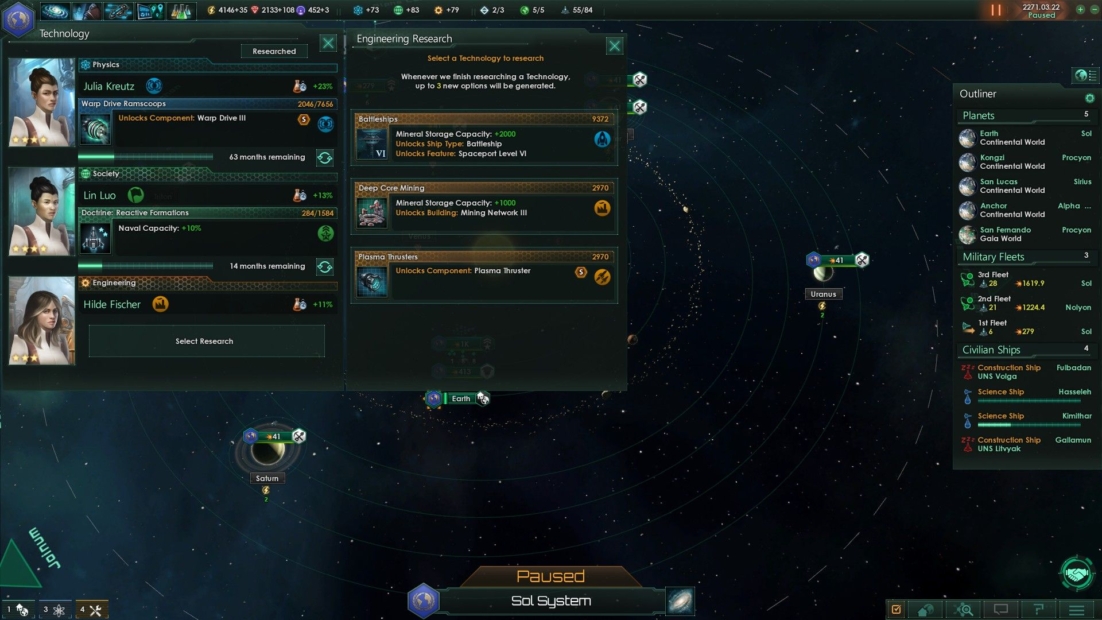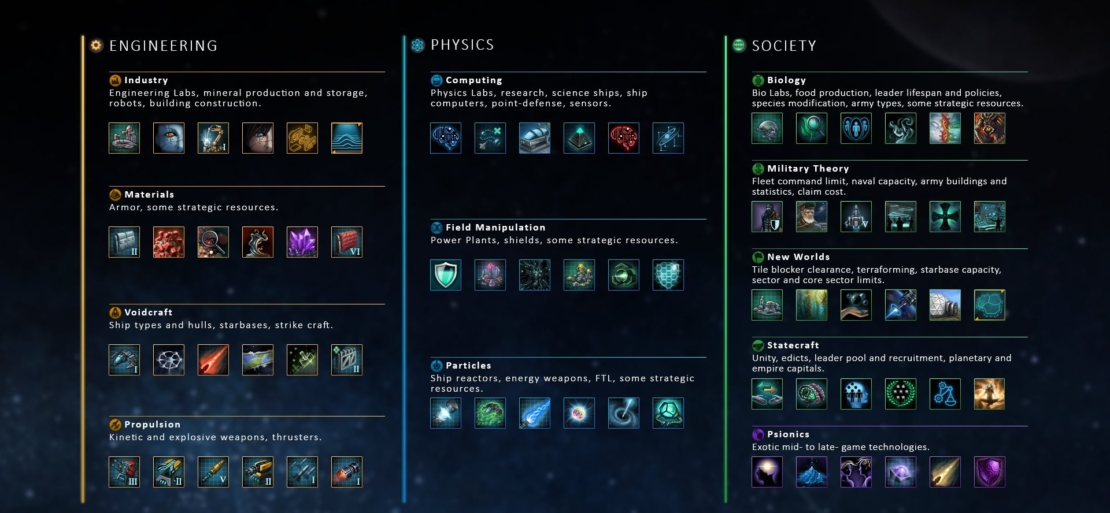The Stellaris research tree can seem intimidating and overwhelming at first glance. Of course, this is nothing new for die-hard Paradox fans, but as a beginner, you’ll quickly be overwhelmed by all the possible options. But don’t be discouraged! In our Stellaris research tree tips and tricks, we’ll show you how to make the most of the tech tree and get the most out of it for your game.
Table of Contents
1) Research in Stellaris in a nutshell
Almost 3,000 different technologies can be researched in Stellaris. They are divided into the areas of society, engineering, and physics. The latter shows surprising parallels to the Star Trek universe and is thus a feast for Trekkis and nerds.

To be able to research, you need so-called research points. How many you have to spend on the individual technologies depends on the size of your empire. The more planets you have and the more you expand, the higher the research costs will be.
The research tree itself works like a game of chance. Each technology has a certain probability of being available to you.
💡 Tip: Also check out our Stellaris Beginner’s Guide!
2) The Stellaris research tree
Despite its random elements, the technology tree in Stellaris can be controlled and influenced to a certain extent. For example, you increase the probability of psionic technologies by choosing the ethic “Spiritualist” at the beginning.

In general, your ethics strongly affect how your diplomacy plays out in the game and what technologies you pull next in each area.
The three areas of the tech tree are divided into the following twelve researchable subcategories:
Physics Research
- Industry
- Materials
- Propulsion
- Spacecraft (Voidcraft)
Society Research
- Biology
- Military Theory
- New Worlds
- Statecraft (Statecraft)
- Psionics
Engineer Research
- Computer (Computing)
- Field Manipulation
- Particles
All research areas have levels. Once you’ve completed 6 technologies in one area, you move up one level.
The further and longer you research, the better you can avoid or resolve negative event chains (such as riots) and you get upgrades for buildings. When one of these upgrades is available, a yellow triangle with an upward-pointing arrow will appear in the upper right corner of the respective terrain field. Clicking it will show you exactly what you can upgrade to.
3) Tips: Research in Stellaris done right
Let’s get to the tangible tips that you can implement immediately. At the beginning of the game, you start with a research ship, a spaceport, a construction ship, and a small fleet. Here is the first tip: Start building a second research ship as soon as possible and recruit an additional researcher, which you then build up piece by piece.
The background is as follows: With the second ship and the extra researcher, you’ll find more anomalies from the beginning and thus receive more bonuses. In addition, you’ll have information about your enemies and habitable planets more quickly.
But what other research should you start with? The answer is tip number 2: Ignore researching a colony ship for now and focus on areas like field manipulation, especially with deflectors and shields.
Experience has shown that this will give you better ships faster. This ultimately increases the strength of your fleet. Although chance still plays a significant role here, you can at least help it along a bit.
You should also complete the “Physics and Engineering Lab” and “Scientific Method” projects as soon as possible. This will help you improve your scientists’ research skills. The sooner you succeed, the greater the effect in the long run.
Tip number 3: Build the Research Nexus megastructure. Although many players consider it unnecessary or too weak, they forget it offers enormous advantages. For example, unlike alternatives like the Ringworlds, it doesn’t require any population or building space. You can just put it anywhere in your star systems.
The biggest advantage of the Nexus is that it gives you a speed bonus of 5, 10 or 15% on your research. With this you can effectively speed up your research and make better progress.
Tip number 4: Have an acting lead scientist for each area in the Stellaris research tree. If you don’t have one, your research speed will decrease.
You may have heard of dangerous research strands. And indeed, there are technologies in Stellaris that have a negative rather than positive effect on your game session. This includes virtually all red techs.
So, here’s tip number 5: weigh the exploration of red technologies carefully. The only reason in their favor would be this: you still need a 6th technology in an area to advance to the next level, and the red techs are the only ones available.
However, you can influence, to some extent, what research you do next. For example, related areas are often available for selection once a technology is unlocked.
This leads us to tip number 6: Choose spaceport upgrades early. This increases the chance of getting powerful cruisers. These have double the cost, but bring up to three times the combat power of the smaller ships.
Tip number 7: When you meet new species, you should research regarding communication possibilities. Otherwise, you will have no way to communicate with them.
As the eighth and last tip, we would like to give you a hint on how to complete projects early and thus save a lot of time: Always check if an icon regarding your current project has appeared next to one of your researchers. If this is the case, click on it and you will be able to unlock the technology much sooner than expected and assign a new task to the researcher.
If you follow all 8 tips, you will be able to research optimally in Stellaris and your empire will be on a solid foundation. Thus, you can defend yourself well and expand and develop your empire without problems.
💡 Tip: Head over to our Stellaris Influence Guide!
Speed up your research in Stellaris with PLITCH!
Of course, we don’t want to deny that the research in Stellaris is fun. But sometimes unlocking a strand can take a long time, and you would prefer to use the new technology immediately instead of having to save up and wait for it to be through.
If this problem sounds familiar, we have the perfect solution: Simply use PLITCH and add as many research points as you want. This will allow you to speed up your research immensely.
Download PLITCH, install the client, and choose your favorites from our 40 Stellaris cheats. Adjust the game to your needs and enjoy it more than ever before.
Check out this blog and our YouTube channel to learn more about PLITCH!
Happy Gaming!


